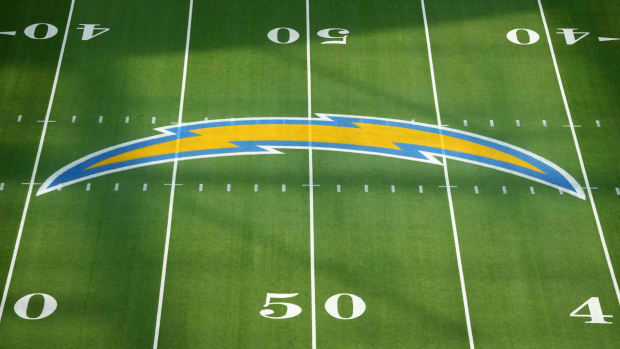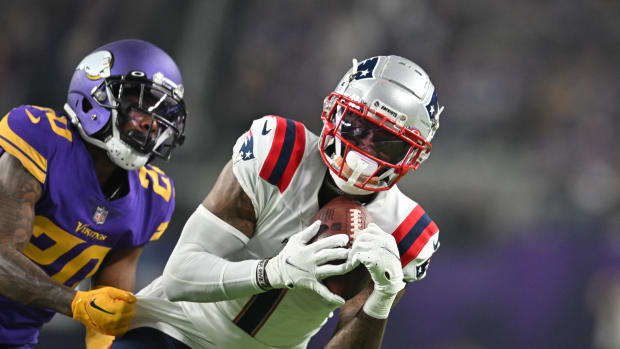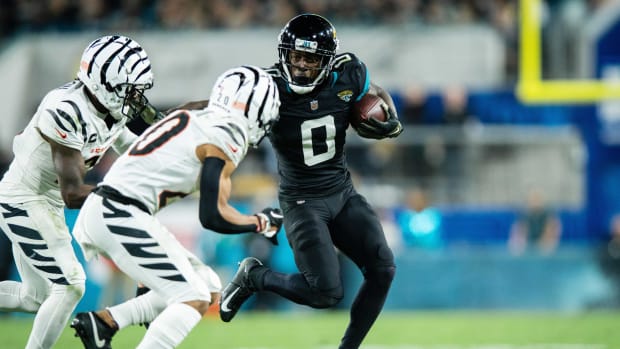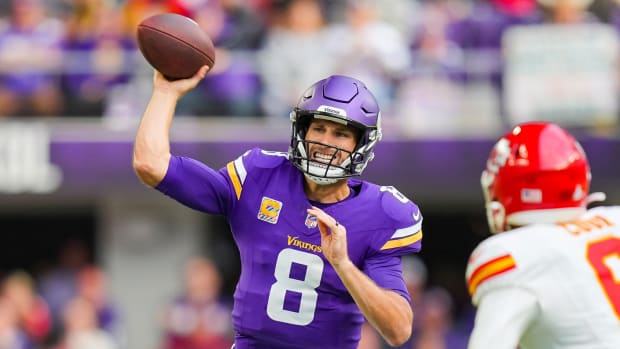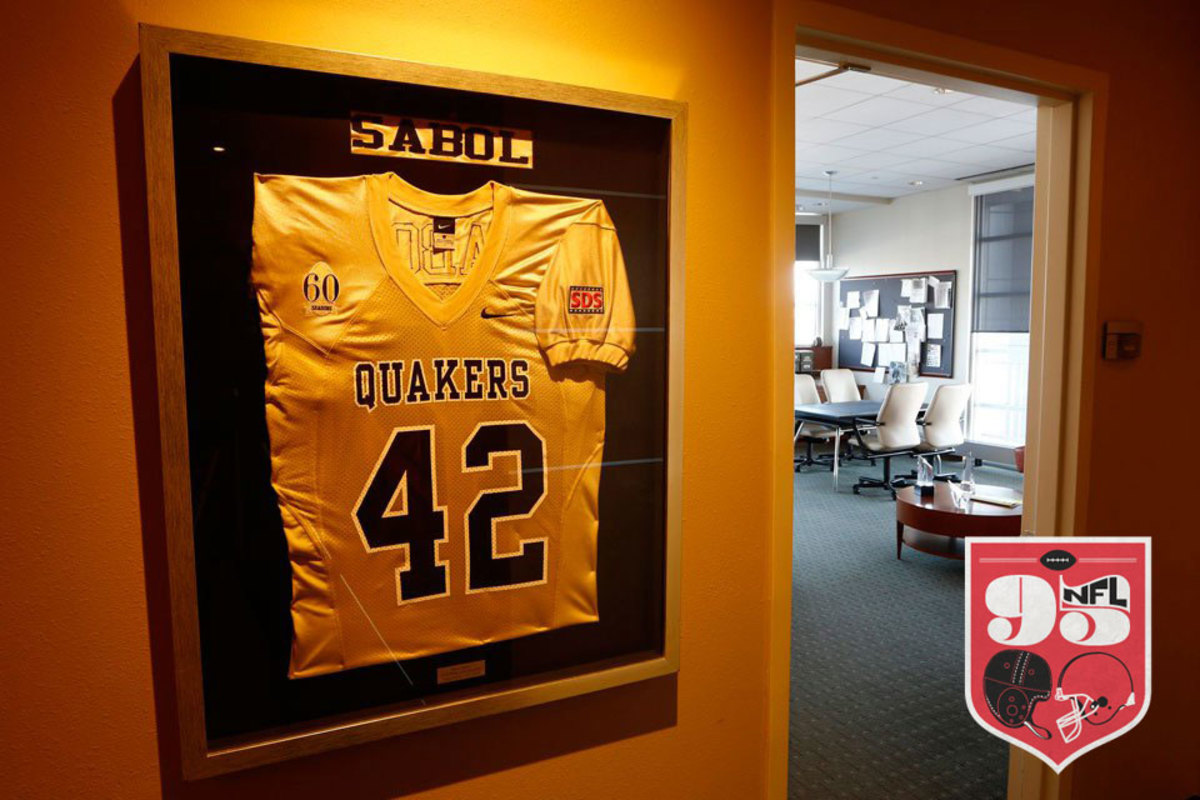
Steve Sabol’s Office: Where Legend Lives On
Editor’s note: This is the first in The MMQB’s 10-part series NFL 95: A History of Pro Football in 95 Objects, commemorating the 95th season of the NFL in 2014. Each Wednesday from now through the start of training camp in July, The MMQB will unveil one long-form piece on an artifact of particular significance to the history of the NFL, accompanied by other objects that trace the rise of professional football in America, from the NFL’s founding in a Hupmobile dealership in Canton in 1920 to its place today at the forefront of American sports and popular culture.
MT. LAUREL, N.J. — The door to Steve Sabol’s office remains open, as always. The lights are on and the computer is plugged in, even though the man who worked behind the large mahogany desk, with a nameplate that reads “King of Football Movies,” died nearly two years ago, at 69, of a tumor on the left side of his brain. Despite his absence, his life’s work pulsates inside these four tan walls, filling the 21-by-22-foot room with a creative energy that spills into the hallways of NFL Films.
Here, in a hideaway corner on the second floor, is where Sabol reviewed highlight films, edited scripts, read as many as five books a week, snipped passages from poems and hosted 5 o’clock cocktails on Fridays. It is where the visionary helped mythologize football, and where the man’s legacy lives on.
A few days after Sabol’s passing, a janitor locked the office. When the staff returned to work the next morning, the building didn’t seem right. NFL Films COO Howard Katz had an assistant unlock the oak door, and it hasn’t been shut since. The space has become a sanctuary for protégés to brainstorm, and a gathering place for an occasional Ketel One on the rocks. Everything in the office remains exactly as Sabol left it, down to the lunch order he scribbled on a white post-it note in September 2012: a wrap and a smoothie.
“Every time I walk by, I say, ‘Hi boss,’ ” says Ken Rodgers, a senior supervising producer. “Maybe you think I’m crazy. Maybe I sound crazy. But I still feel his presence here, like he is still sitting at that desk. It is as if he never left.”
* * *
(Jeff Zelevansky for The MMQB)
You might want to know why we’re here, in this room, looking at a bunch of things a man left behind. Over the next 10 weeks The MMQB will unveil a special project detailing 95 artifacts that tell the history of the NFL, as the league prepares to enter its 95th season. We begin in this office because few have ever loved and cared for the history of the game as much as Steve Sabol. His father, Ed, founded NFL Films in 1962—five years before the first Super Bowl—and with the help of the company’s original programming, from 1967’s groundbreaking They Call It Pro Football to Inside the NFL and Hard Knocks, the pro game came to dominate America’s sporting landscape. Because everything is just as he left it, this office is not so much an artifact as a museum unto itself.
The foyer shines with gold. Light gleams off the five Emmys placed on the center coffee table and dances across the walls, illuminating shelf upon shelf stocked with NFL nostalgia: a Vince Lombardi board game (“The most realistic Pro Football Game ever developed!”); an Otto Graham lamp; figurines galore (Walter Payton, Lawrence Taylor, Lynn Swann, you name it); a leather helmet; and a plate awarded to Pete Rozelle honoring the first NFL-AFL World Championship Game. If you didn’t know Sabol, you’d think the decorations, in this auric tint, are garish. “It’s over the top,” says Patrick Kelleher, another Sabol mentee. “But it’s him.”
Sabol always saw the football field as a movie screen; he was the maestro who paired The Voice of God—John Facenda’s booming intonations of glory—with tight, low-angled shots of spiraling footballs and a stirring soundtrack; the innovator who miked up Hank Stram, giving us “65 Toss Power Trap”; the screenwriter who once wrote, “It starts with a whistle and ends with a gun.”
(Jeff Zelevansky for The MMQB)
He was, above all else, an artist. The gridiron just happened to be one of his many canvases.
Sabol would spend hours on Saturdays driving from flea market to flea market, bartering for bottle caps, matchbooks and faucets that he would craft into collages. Those art projects still line the hallways of NFL Films, and each piece—just like every item in his gilded waiting room—is there because Sabol wanted it in that exact spot. His interior decorating extends all the way downstairs to the cafeteria, where, hanging above the cash register, you’ll find Sabol’s collage titled, “Waitress.” A few years ago somebody replaced it with a photo of Roger Goodell. Sabol noticed right away. “Where is your painting?” he asked the cashier. The woman didn’t know. “I will get it back for you,” Sabol said. The next day order was restored.
Everything about Steve Sabol was deliberate. To the left of his desk you’ll find two large bulletin boards. Pinned to the board farthest left are knickknacks: a keychain from Sabol’s high school alma mater; photos of Sabol’s father, Big Ed; there’s also a copy of “The Autumn Wind,” Steve’s paean to the Oakland Raiders, which became the team’s de facto rallying cry:
The Autumn Wind is a pirate
Blustering in from sea,
With a rollocking song, he sweeps along,
Swaggering boisterously.
His face is weather beaten.
He wears a hooded sash,
With a silver hat about his head,
And a bristling black mustache.
He growls as he storms the country,
A villain big and bold.
And the trees all shake and quiver and quake,
As he robs them of their gold.
The Autumn Wind is a raider,
Pillaging just for fun.
He'll knock you ’round and upside down,
And laugh when he's conquered and won.
Yet there are also large patches of exposed corkboard, a reminder that Sabol left us too soon. On the board to the right he usually posted items about the current season: articles he liked, trends he noticed. Save for a printout of a Washington Post article and a 2012 calendar—turned to the month of September, when he passed—there are few markers of time.
One notecard offers a clue. It is a note Sabol posted while he was undergoing treatment after aphasia began to take his voice.
“Listening to me is like a blocked punt,” it reads. “Life is a process of reinvention... moving on.”
* * *
Inside Steve Sabol’s Office: Navigate the Gigipan below by dragging and scrolling with your mouse, or use the + / icons to zoom in and out. Click the arrow icon to go to a full-screen version. (Gigipan photo by Jeff Zelevansky/The MMQB)
* * *
Kennie Smith began working for Sabol in 1976. Her husband was a twice-cut training camp kicker who found work as a NFL Films cameraman. Sabol didn’t like to hire couples, but decided to help out the Oklahoma high school sweethearts by hiring the 21-year-old Kennie as an assistant. “One of the first assignments he gave me involved scotch tape,” Smith says. “And I cannot tell you how nervous that made me.”
Sabol would spend hours at his desk clipping newspapers, magazines and even books. Anytime he liked a quote, a thought, a comparison, a fact, he’d grab a pair of scissors and snip away. He’d then march over to Smith’s desk and drop off the pile, with scant instructions. Her job: tape the clippings to notecards. But Sabol was a perfectionist, and although he never imposed it on his employees, he expected it. Smith found herself spending even more hours taping and re-taping, centering each item just right.
Smith’s handiwork is catalogued in 34 file boxes lining the back windowsill of Sabol’s office. This is where Sabol’s vision for football—not just as a game of X’s and O’s, but also as a drama that tells a story about human nature—is preserved.
Each box has searchable tabs, with topics ranging from players’ names to general themes, such as losing or greatness. Some notecards feature printed-out quotes; others are straight news clippings, and a few are simply Sabol’s handwriting—large, assertive script with perfectly aligned, right-slanting letters. Some notes are about football, others about baseball or basketball, but many are passages from politicians or poets or music reviews from the arts section. It’s a cultural estuary, a window into how Sabol viewed the game.
Under Late Season: “I like a look of agony,” wrote Emily Dickinson, “Because I know it’s true.”
Under Brett Favre: Mondrian, Van Gogh, Picasso, Renoir.
Under Greatness: Maris is history, but Ruth is legend.
Under Ray Lewis: “Happy is the country that requires no heroes,” the German playwright Bertolt Brecht once wrote.
Under Player to Player: The only thing they have in common is that they sound the same when they eat potato chips.
Under Playoffs: “The emperor does not share your optimistic appraisal of the situation” —Darth Vader
Under Michael Vick: Katharine Hepburn’s presence forces her films to go in directions they cannot possibly follow, adopt strategies they cannot fully sustain, raise issues they cannot adequately resolve.
Under Analysis:“There is nothing more deceptive than obvious fact” —Sherlock Holmes
Under Problems: “The highest reward for a person’s toil is not what they get for it, but what they become by it” —John Ruskin
Sabol’s favorite subject was Vince Lombardi, to whom he dedicated an entire box. In the final card, in the final tab titled End, Sabol wrote in pencil: The story now is not Lombardi in his time, but how he lives in ours. His spirit still summons up the best we have to offer.
* * *
Steve and Ed Sabol. (NFL Photos/AP)
When NFL Films launched in the early ’60s, pro football lagged behind baseball, boxing and college football in popularity. But Big Ed’s intuition and Steve’s innovation helped the NFL grow into a cultural institution. A football signed by each member of the 2011 Pro Football Hall of Fame class sits on the front coffee table of Sabol’s office; Big Ed’s signature is nestled between Richard Dent and Shannon Sharpe.
Around the time the NFL Network launched in 2003, one media member surmised that NFL Films might become extinct. That’s when Steve Sabol’s pride and sense of humor kicked in, and now you’ll find dinosaur figurines sprinkled throughout the office. Those dino figures and the other non-football items in Sabol’s sanctuary are understood best in the context of a note that remains on Sabol’s desk: “Did you make someone laugh today?”
Another note on Sabol’s desk, this one tucked under his keyboard, was one of the last items he brought into his office. It’s a small piece of paper with a few words written in pencil. The letters are faint and barely legible, the scribbling intended as a talking point for the final speech he gave to his employees: “Humility. Make me believe in our company.”
You can’t help but wonder how Sabol might have written his own ending. Would the film about his life’s work call upon the sad violins and a fatalistic narrator to point out that the game clock always marches toward a final gun? Or would it celebrate the triumphs of years gone by, trying to preserve time with a drumbeat that never seems to fade?
The answer, perhaps, is neither.
If you look closely enough at his corkboard, you’ll find thin strips of paper with notes written in Sabol’s fluid, assertive handwriting.
“The soul of a company, not heart,” it reads. “Heart dies, soul is eternal.”
The clock in Steve Sabol’s office still ticks, as always. The phone is still plugged in, but its screen flashes “Do not disturb.” The pink highlighters have dried up, and a Super Bowl V mug is collecting dust. In seemingly every drawer there are packs of notecards still wrapped in plastic.
* * *
Steve Sabol’s Office: Where Legend Lives On
Wise words on Brett Favre. (Emily Kaplan/The MMQB)
Sabol’s file boxes, filled with notes for his scripts. (Jeff Zelevansky for The MMQB)
On the Patriots. (Emily Kaplan/The MMQB)
Heart-stirrers and pulse-pounders! (Emily Kaplan/The MMQB)
On Ray Lewis. (Emily Kaplan/The MMQB)
A scrambling QB. (Emily Kaplan/The MMQB)
Notes on coaches. (Emily Kaplan/The MMQB)
For a profile of a great player. (Emily Kaplan/The MMQB)
Vick as Katharine Hepburn!?! (Emily Kaplan/The MMQB)
On statistics. (Emily Kaplan/The MMQB)
Quoting Emily Dickinson. (Emily Kaplan/The MMQB)
Diamonds in the rough. (Emily Kaplan/The MMQB)
Expanding football’s vocabulary. (Jeff Zelevansky for The MMQB)
Note to self. (Jeff Zelevansky for The MMQB)
A football library. (Jeff Zelevansky for The MMQB)
This is a series about artifacts. But we chose to open it with this man, and this office, because it holds many of the most important pieces of football history that don’t live in Canton, Ohio. And we also wanted to remember that sometimes artifacts aren’t pinned to cork boards, or stuffed away in shoeboxes. Sometimes artifacts are living, breathing things.
Sabol has been gone for nearly two years, but he was careful to make sure his legacy lives on for the next generation—and maybe two—through the spirit of NFL Films.
So we’ll end this story with an enduring part of the Sabol legacy. His name is Mike Mayock.
You probably know Mayock as an analyst on NFL Network. He owes his career to Sabol. After his playing days as a defensive back for Boston College and the New York Giants, Mayock found himself selling commercial real estate in South Jersey. “And I hated it,” Mayock says.
Through a friend of a friend he found himself in Sabol’s office in the mid-1990s, looking for a way back into football. There are dozens of people with stories like this, mentees and protégés whom Sabol has influenced over the years. Each has a common thread: “Steve could sense if you had the passion,” Mayock says. “He believed in hiring people who not only had a talent, but who also had passion. He believed they would do great things.” So Sabol insisted that Mayock, the 10th-round draft pick turned salesman, sit in front of the camera for an audition tape. “We had some great laughs about that later,” Mayock says fondly.
Since then, Mayock has emerged as one of the league’s authoritative voices thanks to his extensive game analysis, a growing subculture that NFL Films helped foster. As much as the company is about mythology and romance and history, it is also about the sport of football. The NFL Films headquarters, a sprawling two-story complex in suburban Philadelphia, is a vault for thousands of hours of game tape, including All-22 or Coaches’ Cuts that can’t be found anywhere else. Media members from around the country flock here, with clicker in hand, to watch, rewind and understand the game better. This is their sanctuary.
(Jeff Zelevansky for The MMQB)
Whenever Mayock arrives at a football stadium, he goes out of his way to walk out onto the field, his senses taking him back to his playing days as a defensive back. When he stopped in to visit NFL Films last summer, he slowly walked around Sabol’s office. “It was the same feeling as if I was at the stadium,” Mayock says. “It just kind of took me back, and I felt like I was there with him, and I was reminded of what this is all about.”
And he can still feel his aura, in this room. The one with the door still wide open.
[si_video id="video_2FE64DDF-94E0-92E2-24DF-FBCEBF68CD5E"]
Week 1 Artifacts
Chicago’s 1933 Championship Bearskin It’s a long way from the animal pelts George Halas gave to the winners of the first NFL title game to the Tiffany-designed Lombardi Trophy and the gem-encrusted rings that go to today’s champs. read more → |
Peyton Manning’s Broncos Contract The free-agency era kicked off in ’93 with Reggie White and reached its high point in the spectacle of the game’s best player being courted coast-to-coast in 2012 before landing in Denver. read more → |
Rocky Bleier’s Purple Heart Dozens of NFL players, coaches and personnel have served their country in wars overseas, including the Steelers’ future Super Bowl-winning fullback who earned distinction for heroism in Vietnam. read more → |
George Preston Marshall’s Fur Coat The forerunner of Al Davis and Jerry Jones, Washington’s fur-coat wearing boss reveled in showmanship, the first in a line of eccentric and controversial NFL owners and a lightning rod to this day. read more → |
Bill Belichick’s Super Bowl XXV Game Plan His innovative schemes and personnel packages shut down the dynamic Bills offense, foreshadowing what was to come when he built the Patriots dynasty, and evidence of one of the game’s most creative minds. read more → |
Don Hutson’s Cape He might as well have been Superman: Long before Jerry Rice and Megatron, the Packers great practically invented the position of wide receiver, with numbers that dwarfed any other player at the position in his time. read more → |
Super Bowl I Ticket At 10 bucks—10 bucks!—it hardly broke a fan’s bank to get in, and still the L.A. Coliseum had swathes of empty seats when the Packers and Chiefs met in the first the first “AFL-NFL World Championship Game.” read more → |
Tom Brady’s 2000 Draft Card There’s no greater reminder of what a crapshoot the NFL draft is than this scrap of paper with the scribbled name of a scrawny, slow-footed Michigan quarterback who would go on to win three Super Bowls and marry a supermodel. read more → |
Sammy Baugh’s Shoes One of the first quarterbacks to employ the forward pass consistently, Washington’s star QB in the ’30s and ’40s offered a glimpse of what football could become—and in 1943 he had arguably the greatest all-around season of any player. read more → |
Credits for home page graphic: Photo Illustration by Lynne Carty, New York Times Co./Getty Images, Wide World Photos/AP, Robert Riger/Getty Images, Walter Iooss Jr. for Sports Illustrated, Neil Leifer/Sports Illustrated, Harry Cabluck/AP, Herb Scharfman /Sports Illustrated, Damian Strohmeyer/Sports Illustrated, Robert Beck/Sports Illustrated, Damian Strohmeyer for Sports Illustrated





















































